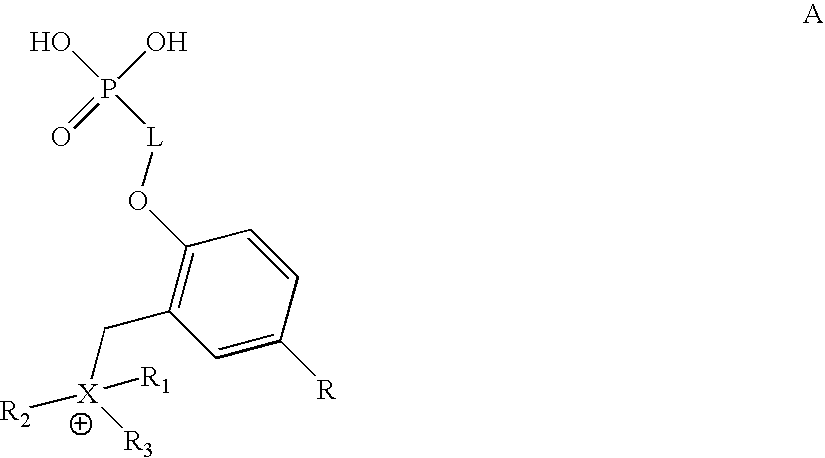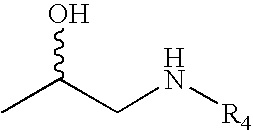Monophosphates as Mutual Prodrugs of Muscarinic Receptor Antagonists and Beta-Agonists for the Treatment of COPD And Chronic Bronchitis
a technology of muscarinic receptor antagonists and monophosphates, which is applied in the direction of phosphorous compound active ingredients, drug compositions, biocides, etc., can solve the problems of reducing gi motility, affecting the ocular accommodation, and undetectable cardiac side effects, so as to minimize the rapid systemic absorption and eliminate the effect of systemic side effects
- Summary
- Abstract
- Description
- Claims
- Application Information
AI Technical Summary
Benefits of technology
Problems solved by technology
Method used
Image
Examples
example 1
Phosphorobromidic Acid Di-Tert-Butyl Ester
[0086]
[0087]The title phosphorylating agent was prepared according to modified conditions compared to those described by Gajda and Zwierzak (1976). By lowering the temperature of the reaction to 15° C. and decreasing the reaction time to 2.5 hours the title compound obtained in our hands had better purity then when applying the literature conditions (25° C. for 4 hours). The title phosphobromidate is unstable and was immediately used for the phosphorylation reactions (see Examples 4 and 10).
[0088]Examples 2-6 illustrate the synthesis of the racemic phosphorylated derivative of salmeterol (see Scheme I).
example 2
[2-Hydroxy-2-(4-hydroxy-3-hydroxymethyl-phenyl)-ethyl]-[6-(4-phenyl-butoxy)-hexyl-carbamic acid tent-butyl ester
[0089]
[0090]Commercially available salmeterol xinafoate (6.04 g, 10 mmol) and potassium carbonate (1.39 g, 10 mmol) were suspended with stirring in a 1,4-dioxane / water mixture (1:1, 80 mL). Then, di-t-butyl-dicarbonate (2.40 g, 11 mmol) dissolved in 1,4-dioxane (10 mL) was added dropwise while continuing stirring at room temperature. The TLC analysis after 30 minutes showed only traces of starting material. After 2 hours 1,4-dioxane was evaporated and the suspension formed was diluted with water and extracted twice with chloroform (125 mL total). Then, the organic layer was washed with saturated sodium bicarbonate, brine and dried over anhydrous magnesium sulfate. The crude material obtained after decantation and evaporation was purified by silica gel chromatography eluting with the ethyl acetate / hexane mixture (1:1). The title compound (4.61 g, 89%) was obtained as a glas...
example 3
[2-(3-Formyl-4-hydroxy-phenyl)-2-hydroxy-ethyl]-[6-(4-phenyl-butoxy)-hexyl]-carbamic acid tert-butyl ester
[0091]
[0092]The N-Boc-salmeterol described in Example 2 (3.24 g, 6.28 mmol) was dissolved in chloroform (50 mL) and the activated manganese oxide (IV) (6.44 g, 85% w / w, 63 mmol) was added in portions with vigorous stirring. After 24 hours at room temperature the slurry was filtered through a pad of Celite, followed by concentration of the filtrate combined with the chloroform washes. The crude residue thus obtained was purified by silica gel chromatography using ethyl acetate / hexane mixture (1:5) yielding the title aldehyde 1 (2.45 g, 77%). LCMS: 96%, MNa+ 536.3 (exact mass 513.3 calcd for C30H43NO6).
PUM
| Property | Measurement | Unit |
|---|---|---|
| molecular weight | aaaaa | aaaaa |
| temperature | aaaaa | aaaaa |
| temperature | aaaaa | aaaaa |
Abstract
Description
Claims
Application Information
 Login to View More
Login to View More - R&D
- Intellectual Property
- Life Sciences
- Materials
- Tech Scout
- Unparalleled Data Quality
- Higher Quality Content
- 60% Fewer Hallucinations
Browse by: Latest US Patents, China's latest patents, Technical Efficacy Thesaurus, Application Domain, Technology Topic, Popular Technical Reports.
© 2025 PatSnap. All rights reserved.Legal|Privacy policy|Modern Slavery Act Transparency Statement|Sitemap|About US| Contact US: help@patsnap.com



